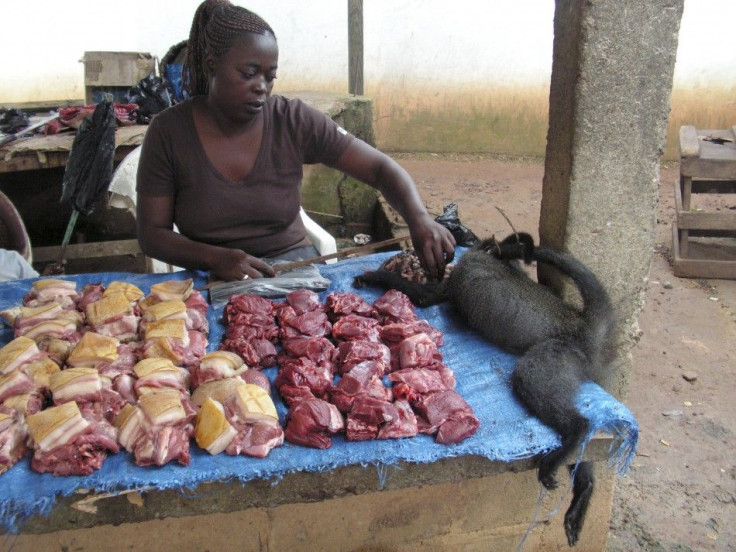Bushmeat Reduces Anemia in Children, but Conservation Goal Remains

Eating bushmeat is a complex and controversial culinary act, a balance between meeting the nutritional needs of some of the world's poorest people and the striving for conservational needs of some of the most vulnerable forest and endangered wildlife.
The act of eating wild and potentially threatened species also assists in child nutrition in countries where a dinner with meat may be an annual occurrence. Bushmeat decreases anemia in children and increases oxygen-carrying hemoglobin their blood, according to research released Monday, suggestive that bushmeat can benefit developing nations even if the practice erodes the countryside fauna.
The year-long study in the Makira Protected Area, a diverse region in northeast Madagascar, found 30 percent greater anemia in 77 children 12 years and younger compared to children who had access to bushmeat. Anemia, a deficiency of iron that affects nearly 2 billion people worldwide, can cause developmental delays and cognitive problems in children.
The paper appeared Monday in the online edition of the journal the Proceedings of the National Academy of Sciences.
This research highlights a tension between conservation policy and human health and livelihoods, but solutions could be designed to benefit both, said Christopher Golden, the lead researcher and postdoc at the Harvard University Center for the Environment. Colleagues at the University of California, Berkeley and the Wildlife Conservation Society in Soavimbahoaka, Madagascar also contributed to the research.
Madagascar is one of the world's poorest nations where bushmeat has threatened several species, including lemurs.
People there eat beef maybe one to four times a year, and chicken maybe once a month, Golden said. So the wild foods they're receiving are enormously important, because the meat is providing the nutrients they aren't getting elsewhere.
The peer-reviewed research wasn't a call to advocate bushmeat consumption and to stop conservation efforts, the authors noted, but added to the conversation of how to balance the complex mix of policy and nutrition in a cultural framework.
If policymakers were to follow the recommendations developed from information this research provides then they would work to improve the effectiveness of wildlife conservation while identifying locally-relevant solutions to the nutritional needs of the people, Heather Eves, former director of the Bushmeat Crisis Task Force that disbanded in 2009, wrote in an email. This would be a very positive outcome both for wildlife and for people in the present and future generations.
Eves continued: The challenge, which was not discussed in the paper, is the estimated 2.97 percent population growth rate in Madagascar which means that even if consumption of wildlife continued at the present rate the same loss of nutrition would effectively occur among the population due to the increased numbers of people (assuming wildlife numbers remained constant - which they will not as they will continue to decline). So. If the thesis were adopted then governments would work more effectively to build a mechanism that allows for multi-disciplinary collaboration among key stakeholders (local communities, public health sector, agriculture/animal husbandry experts, wildlife conservation professionals) to identify the protein (animal-specific to assure bio-available iron) alternatives necessary to substitute for reduced access to wildlife while increasing enforcement of existing wildlife laws to assure that there is a wildlife resource base to sustainably support local needs.
Many supporters of the bushmeat trade say they eat the rarified meat because of its taste and also from tradition. A 2011 survey found that 88 percent of rural and urban households ate bushmeat. The survey included 1,050 households in the Congo capital of Brazzaville and was published in the online journal Tropical Conservation Science.
Nearly 70 percent of urban respondents said that they had been born in rural regions and said they ate bushmeat because of its rooted cultural value.
In poor regions like Madagascar, eating bushmeat is seen as a necessity for some. It is clearly not environmentally sustainable for children to eat endangered animals, but in the context of remote, rural Madagascar, households don't always have a choice, Lia Fernald, U.C. Berkeley associate professor in the School of Public Health, who helped design the study. In places where a diverse range of nutritious food is unavailable, children rely upon animal-source foods - milk, eggs and meat - for critical nutrients like fats, protein, zinc and iron. What we need for these children are interventions that can provide high-quality food sources that are not endangered.
However, the research could be taken the wrong way, experts say, and lend a false credibility to hunting wild game.
This study was meant to provide scientific evidence and quantification of an often-suggested but not well-studied component of the bushmeat trade - the real impacts of wildlife declines on human livelihoods (income and health), Eves wrote. When taken on its own the messaging from the research can be simplified and turned around to offer an opposite message: to suggest that people must have access to wildlife as it improves childhood nutrition without understanding that 'access to wildlife' is the issue at hand - wildlife is in dramatic decline around the globe. We must first conserve it if humans are to have access to it.
How to develop resources outside of bushmeat remains a challenge when wildlife constitutes a minimum 20 percent of protein in the rural diets of residents across 62 countries, according to a 2008 report from the Secretariat of the Convention of Biological Diversity, a position created during the 1992 convention.
The authors suggested, improving poultry husbandry conditions and the dissemination of poultry vaccines might provide a preferred nutritional alternative to wildlife that could ease hunting pressure on endangered biodiversity.
Whether this happens or not will depend on long-term management, Eves said.
Research elsewhere suggests that if protein alternatives are provided without enforcement then they simply become another protein supplement along with the illegal wildlife harvests, Eves said. Both must be developed and implemented along with community-wide communications and collaboration toward co-management with other stakeholders (livestock experts, wildlife personnel etc.).
© Copyright IBTimes 2024. All rights reserved.




















